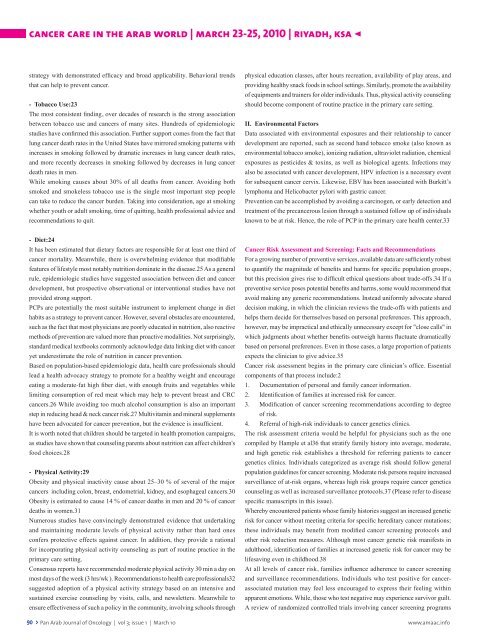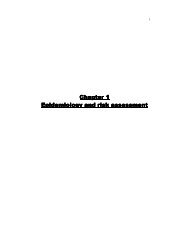Pan Arab Journal of Oncology - Arab Medical Association Against ...
Pan Arab Journal of Oncology - Arab Medical Association Against ...
Pan Arab Journal of Oncology - Arab Medical Association Against ...
You also want an ePaper? Increase the reach of your titles
YUMPU automatically turns print PDFs into web optimized ePapers that Google loves.
cancer care in the arab world | march 23-25, 2010 | riyadh, ksa <<br />
strategy with demonstrated efficacy and broad applicability. Behavioral trends<br />
that can help to prevent cancer.<br />
- Tobacco Use:23<br />
The most consistent finding, over decades <strong>of</strong> research is the strong association<br />
between tobacco use and cancers <strong>of</strong> many sites. Hundreds <strong>of</strong> epidemiologic<br />
studies have confirmed this association. Further support comes from the fact that<br />
lung cancer death rates in the United States have mirrored smoking patterns with<br />
increases in smoking followed by dramatic increases in lung cancer death rates,<br />
and more recently decreases in smoking followed by decreases in lung cancer<br />
death rates in men.<br />
While smoking causes about 30% <strong>of</strong> all deaths from cancer. Avoiding both<br />
smoked and smokeless tobacco use is the single most important step people<br />
can take to reduce the cancer burden. Taking into consideration, age at smoking<br />
whether youth or adult smoking, time <strong>of</strong> quitting, health pr<strong>of</strong>essional advice and<br />
recommendations to quit.<br />
- Diet:24<br />
It has been estimated that dietary factors are responsible for at least one third <strong>of</strong><br />
cancer mortality. Meanwhile, there is overwhelming evidence that modifiable<br />
features <strong>of</strong> lifestyle most notably nutrition dominate in the disease.25 As a general<br />
rule, epidemiologic studies have suggested association between diet and cancer<br />
development, but prospective observational or interventional studies have not<br />
provided strong support.<br />
PCPs are potentially the most suitable instrument to implement change in diet<br />
habits as a strategy to prevent cancer. However, several obstacles are encountered,<br />
such as the fact that most physicians are poorly educated in nutrition, also reactive<br />
methods <strong>of</strong> prevention are valued more than proactive modalities. Not surprisingly,<br />
standard medical textbooks commonly acknowledge data linking diet with cancer<br />
yet underestimate the role <strong>of</strong> nutrition in cancer prevention.<br />
Based on population-based epidemiologic data, health care pr<strong>of</strong>essionals should<br />
lead a health advocacy strategy to promote for a healthy weight and encourage<br />
eating a moderate-fat high fiber diet, with enough fruits and vegetables while<br />
limiting consumption <strong>of</strong> red meat which may help to prevent breast and CRC<br />
cancers.26 While avoiding too much alcohol consumption is also an important<br />
step in reducing head & neck cancer risk.27 Multivitamin and mineral supplements<br />
have been advocated for cancer prevention, but the evidence is insufficient.<br />
It is worth noted that children should be targeted in health promotion campaigns,<br />
as studies have shown that counseling parents about nutrition can affect children's<br />
food choices.28<br />
- Physical Activity:29<br />
Obesity and physical inactivity cause about 25–30 % <strong>of</strong> several <strong>of</strong> the major<br />
cancers including colon, breast, endometrial, kidney, and esophageal cancers.30<br />
Obesity is estimated to cause 14 % <strong>of</strong> cancer deaths in men and 20 % <strong>of</strong> cancer<br />
deaths in women.31<br />
Numerous studies have convincingly demonstrated evidence that undertaking<br />
and maintaining moderate levels <strong>of</strong> physical activity rather than hard ones<br />
confers protective effects against cancer. In addition, they provide a rational<br />
for incorporating physical activity counseling as part <strong>of</strong> routine practice in the<br />
primary care setting.<br />
Consensus reports have recommended moderate physical activity 30 min a day on<br />
most days <strong>of</strong> the week (3 hrs/wk ). Recommendations to health care pr<strong>of</strong>essionals32<br />
suggested adoption <strong>of</strong> a physical activity strategy based on an intensive and<br />
sustained exercise counseling by visits, calls, and newsletters. Meanwhile to<br />
ensure effectiveness <strong>of</strong> such a policy in the community, involving schools through<br />
physical education classes, after hours recreation, availability <strong>of</strong> play areas, and<br />
providing healthy snack foods in school settings. Similarly, promote the availability<br />
<strong>of</strong> equipments and trainers for older individuals. Thus, physical activity counseling<br />
should become component <strong>of</strong> routine practice in the primary care setting.<br />
II. Environmental Factors<br />
Data associated with environmental exposures and their relationship to cancer<br />
development are reported, such as second hand tobacco smoke (also known as<br />
environmental tobacco smoke), ionizing radiation, ultraviolet radiation, chemical<br />
exposures as pesticides & toxins, as well as biological agents. Infections may<br />
also be associated with cancer development, HPV infection is a necessary event<br />
for subsequent cancer cervix. Likewise, EBV has been associated with Burkitt’s<br />
lymphoma and Helicobacter pylori with gastric cancer.<br />
Prevention can be accomplished by avoiding a carcinogen, or early detection and<br />
treatment <strong>of</strong> the precancerous lesion through a sustained follow up <strong>of</strong> individuals<br />
known to be at risk. Hence, the role <strong>of</strong> PCP in the primary care health center.33<br />
Cancer Risk Assessment and Screening: Facts and Recommendations<br />
For a growing number <strong>of</strong> preventive services, available data are sufficiently robust<br />
to quantify the magnitude <strong>of</strong> benefits and harms for specific population groups,<br />
but this precision gives rise to difficult ethical questions about trade-<strong>of</strong>fs.34 If a<br />
preventive service poses potential benefits and harms, some would recommend that<br />
avoid making any generic recommendations. Instead uniformly advocate shared<br />
decision making, in which the clinician reviews the trade-<strong>of</strong>fs with patients and<br />
helps them decide for themselves based on personal preferences. This approach,<br />
however, may be impractical and ethically unnecessary except for "close calls" in<br />
which judgments about whether benefits outweigh harms fluctuate dramatically<br />
based on personal preferences. Even in those cases, a large proportion <strong>of</strong> patients<br />
expects the clinician to give advice.35<br />
Cancer risk assessment begins in the primary care clinician’s <strong>of</strong>fice. Essential<br />
components <strong>of</strong> that process include:2<br />
1. Documentation <strong>of</strong> personal and family cancer information.<br />
2. Identification <strong>of</strong> families at increased risk for cancer.<br />
3. Modification <strong>of</strong> cancer screening recommendations according to degree<br />
<strong>of</strong> risk.<br />
4. Referral <strong>of</strong> high-risk individuals to cancer genetics clinics.<br />
The risk assessment criteria would be helpful for physicians such as the one<br />
compiled by Hample et al36 that stratify family history into average, moderate,<br />
and high genetic risk establishes a threshold for referring patients to cancer<br />
genetics clinics. Individuals categorized as average risk should follow general<br />
population guidelines for cancer screening. Moderate risk persons require increased<br />
surveillance <strong>of</strong> at-risk organs, whereas high risk groups require cancer genetics<br />
counseling as well as increased surveillance protocols.37 (Please refer to disease<br />
specific manuscripts in this issue).<br />
Whereby encountered patients whose family histories suggest an increased genetic<br />
risk for cancer without meeting criteria for specific hereditary cancer mutations;<br />
these individuals may benefit from modified cancer screening protocols and<br />
other risk reduction measures. Although most cancer genetic risk manifests in<br />
adulthood, identification <strong>of</strong> families at increased genetic risk for cancer may be<br />
lifesaving even in childhood.38<br />
At all levels <strong>of</strong> cancer risk, families influence adherence to cancer screening<br />
and surveillance recommendations. Individuals who test positive for cancerassociated<br />
mutation may feel less encouraged to express their feeling within<br />
apparent emotions. While, those who test negative may experience survivor guilt.<br />
A review <strong>of</strong> randomized controlled trials involving cancer screening programs<br />
90 > <strong>Pan</strong> <strong>Arab</strong> <strong>Journal</strong> <strong>of</strong> <strong>Oncology</strong> | vol 3; issue 1 | March 10 www.amaac.info









